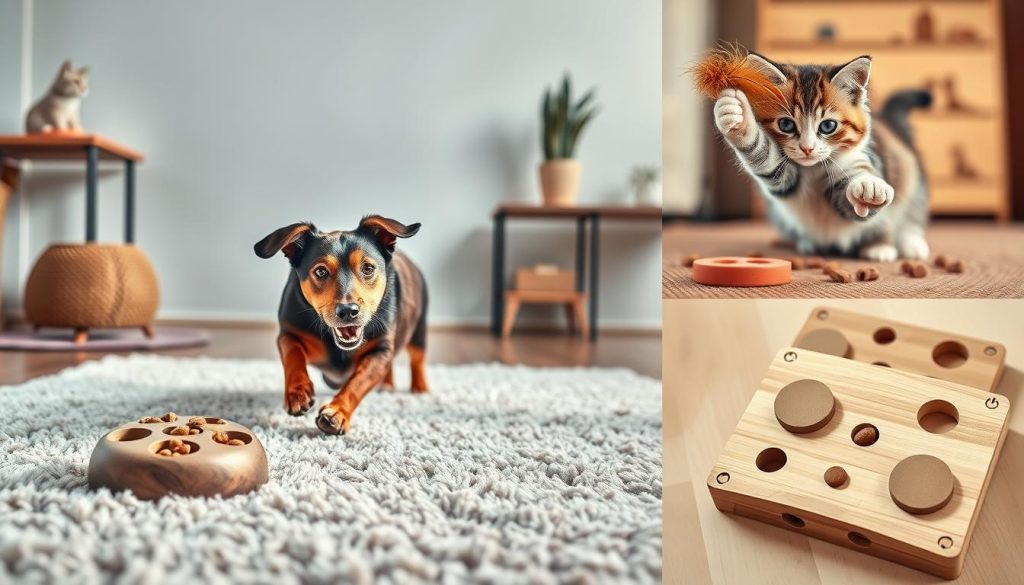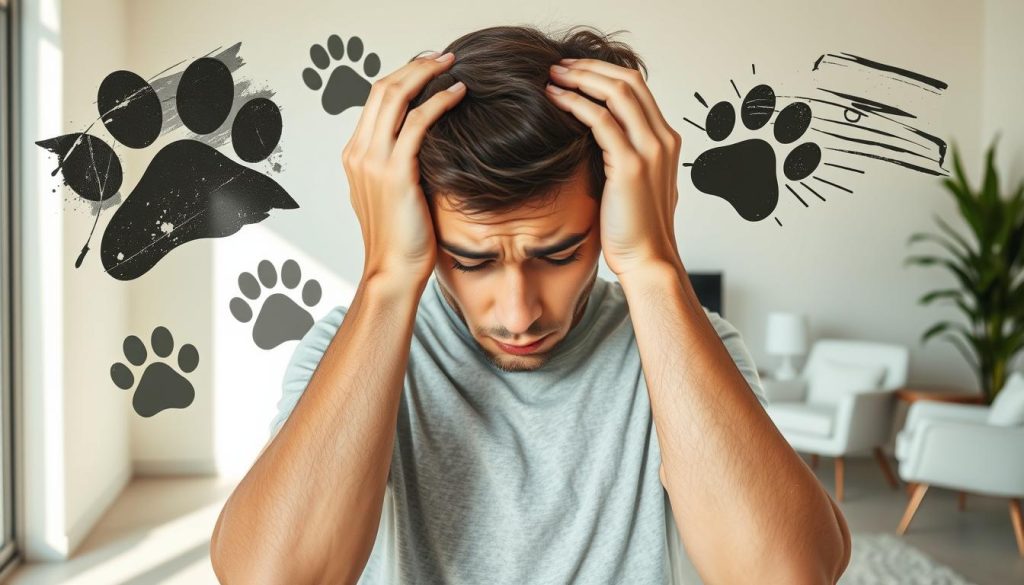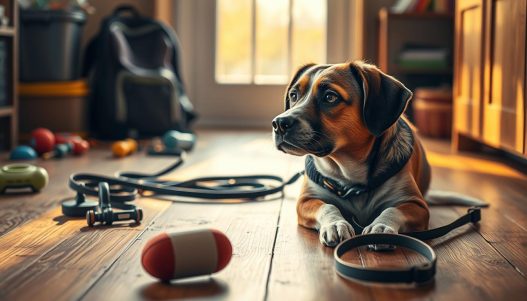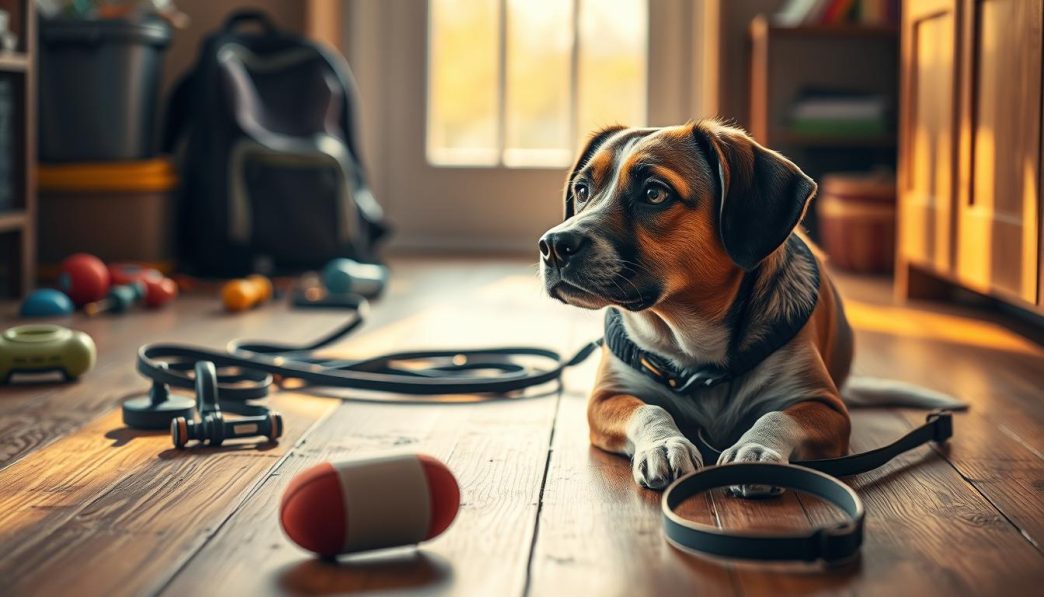As the back-to-school season approaches, many pet owners worry about how their furry friends will adjust. Pets can feel separation anxiety when left alone for a long time. This causes stress for both pets and owners.
Easing anxiety in pets needs a careful plan. By using back-to-school tips that fit your pet’s needs, you can lessen their stress. This makes the transition easier for them.
Key Takeaways
- Understand the causes of pet separation anxiety
- Learn effective back-to-school tips to ease your pet’s anxiety
- Discover ways to create a comforting environment for your pet
- Implement strategies to reduce your pet’s stress during the back-to-school season
- Find out how to establish a calming pre-departure routine
Understanding Pet Separation Anxiety During Back-to-School Season
As back-to-school season nears, many pet owners are concerned about their pets’ well-being. Pets love routine, and a sudden change can be tough for them. The shift from a relaxed summer to a structured school year can be challenging.
How Pets Experience the Sudden Change in Routine
Pets are creatures of habit and can get anxious when their routine changes. In the summer, pets are used to having their owners around more. But when school starts, their owners are away, making pets feel abandoned or anxious.
The Emotional Impact of Empty Houses on Dogs and Cats
Empty houses can have a big emotional impact on dogs and cats. Dogs might bark a lot, get destructive, or show other signs of distress. Cats may hide, become aggressive, or show other signs of anxiety. It’s important for pet owners to understand these behaviors and offer support and comfort during this time.
Recognizing the Signs of Separation Anxiety in Your Pet
Separation anxiety is common in pets when school starts. Knowing the signs is key to helping them. Pets show anxiety in different ways, and it’s important to understand these behaviors.
Common Behavioral Indicators in Dogs
Dogs with separation anxiety might chew on furniture or bark a lot. These are signs they’re feeling anxious.
Destructive Behaviors and Excessive Vocalization
Dogs might chew on things they shouldn’t or bark a lot. This is their way of showing they’re upset.
Changes in Eating and Bathroom Habits
Some dogs might not want to eat or have accidents in the house. These are signs of anxiety too.
How Cats Display Separation Anxiety
Cats also get anxious when left alone. Their signs might be less obvious than a dog’s.
Litter Box Issues and Excessive Grooming
Cats might have trouble using the litter box or groom too much. This can cause hair loss or skin problems.
Clingy Behavior and Vocalization
Cats might follow their owners everywhere or meow a lot when alone. This is their way of showing they’re anxious.
Differentiating Anxiety from Other Behavioral Issues
It’s important to tell if your pet’s behavior is due to anxiety or something else. A vet or pet behaviorist can help figure this out.
| Behavioral Indicator | Dogs | Cats |
|---|---|---|
| Destructive Behavior | Chewing furniture, digging | Scratching furniture, knocking over objects |
| Vocalization | Barking, howling | Meowing, hissing |
| Changes in Habits | Loss of appetite, urinating/defecating indoors | Litter box issues, changes in eating habits |
Pet Separation Anxiety: Preparing Your Pet for Back-to-School Routines
To help your pet feel better when you leave, start preparing them early. Change their daily routine, make them associate your leaving with good things, and show them you always come back.
Two-Week Preparation Timeline Before School Starts
Begin adjusting your pet’s routine two weeks before school starts. Change their meal times, play, and alone time to match school hours. For example, if you feed them at 8 AM, try 7 AM to get them used to an earlier time.
- Gradually adjust feeding times
- Modify play and exercise routines
- Increase alone time gradually
Creating Positive Associations with School Items
Make your pet see school items like backpacks and lunchboxes as good things. Leave them out with treats or toys. This makes your pet think these items are safe.
Teaching Your Pet That Departures Are Normal and Temporary
Practice leaving and coming back to show your pet you always return. Start with short times and get longer. This helps them feel less anxious.
Key tips:
- Keep departures and arrivals low-key
- Leave a treat-filled toy to keep your pet occupied
- Return before your pet becomes anxious
Establishing a Consistent Daily Schedule That Mimics School Days
Consistency is key for your pet to adjust to the back-to-school routine. A daily schedule that mirrors school days can help reduce separation anxiety.
Morning Routines That Set the Right Tone
Starting the day positively is important. Morning routines like feeding, walking, and playtime signal it’s time to be active. This helps create a sense of normalcy and reduces anxiety.
Implementing Practice Departures and Returns
Practice departures and returns teach your pet that your leaving and coming back are normal. Start with short departures and gradually increase the time to help your pet adjust.
Adjusting Feeding and Walking Times Gradually
Adjusting your pet’s feeding and walking times to match the school day schedule is helpful. Make these changes gradually to avoid shocking your pet.
By using these strategies, you can make your pet feel more secure. This helps reduce separation anxiety as the new school year starts.
Creating a Comfortable Environment for Your Pet’s Alone Time
Pets love routine and comfort. A good environment is key for their happiness. It helps lower their anxiety when they’re alone.
Setting Up a Designated Safe Space
Make a special safe space for your pet. It should be quiet, comfy, and free from distractions.
Crate Training vs. Room Access Considerations
Crate training gives pets a sense of safety. Room access lets them roam freely. Think about what your pet likes best.
Making the Space Inviting and Secure
Put in your pet’s favorite toys and a cozy blanket. Make sure it’s safe and can’t be escaped.
Comfort Items and Familiar Scents
Comfort items like toys or blankets reassure pets. Familiar scents, like a worn t-shirt, also calm them down.
Managing Environmental Factors: Light, Temperature, and Noise
Adjusting light, temperature, and noise makes a space comfy. It helps create a peaceful atmosphere for your pet.
| Environmental Factor | Tips for Management |
|---|---|
| Light | Use curtains or blinds to control light levels, ensuring it’s not too harsh or dim. |
| Temperature | Maintain a comfortable temperature range (around 68-72°F) to keep your pet cozy. |
| Noise | Use white noise machines or calming music to mask any jarring sounds that might disturb your pet. |
Enrichment Activities to Keep Your Pet Mentally Stimulated
Engaging your pet in enrichment activities can greatly improve their mental health when you’re away. Pets can get bored or anxious when left alone. So, it’s important to give them stimulating activities.
These activities keep your pet’s mind active. They also help reduce separation anxiety symptoms.

Interactive Toys and Puzzle Feeders for Different Pet Types
Interactive toys and puzzle feeders are great for mental stimulation. Dogs love puzzle toys that dispense treats, challenging them to get the reward. Cats enjoy toys that mimic prey, like feather wands or laser pointers, which trigger their hunting instincts.
Using these toys keeps your pets engaged for a long time.
Food-Based Enrichment to Extend Engagement Time
Food-based enrichment activities are also effective. For dogs, hiding treats around the house or yard encourages sniffing and searching. This mimics foraging behavior.
For cats, treat-dispensing toys or interactive feeders make mealtime fun. This makes eating a more enjoyable and challenging experience. It also extends the time they spend on a task.
Rotating Toys and Creating Novelty in the Environment
To keep enrichment activities exciting, it’s key to rotate toys regularly. Pets can quickly get used to the same toys. Introducing new ones or bringing back old favorites can spark their interest again.
Also, rearranging the environment or adding new objects to explore provides mental stimulation. This can be as simple as moving furniture or introducing a new cardboard box for your cat to investigate.
Exercise Strategies to Reduce Anxiety and Burn Excess Energy
Exercise is key in helping pets feel better during the back-to-school season. It reduces anxiety and burns off extra energy. By adding fun physical activities to their day, pets can feel more relaxed and happy.
Pre-Departure Exercise Routines for Dogs
Dogs need a good exercise plan before their owners leave. A morning jog, a game of fetch, or agility training are great. These activities keep them active and mentally sharp, easing their anxiety.
- Brisk morning walks to kick-start the day
- Playtime activities like fetch or tug-of-war
- Agility training for physical and mental challenge
Play Sessions for Cats Before Alone Time
Cats need playtime before being left alone. Using feather wands, laser pointers, or toys can keep them active and calm. It taps into their natural hunting drive, helping them relax.
- Using feather wands or laser pointers for interactive play
- Engaging cats with puzzle toys or treat-dispensing toys
- Creating a climbing structure for physical activity
Evening Activities to Reconnect and Reinforce Bonds
In the evening, activities that strengthen the bond between pets and owners are best. Gentle petting, massages, or quiet time together are great. These moments calm pets and make them feel safe.
| Activity | Benefits for Pets |
|---|---|
| Brisk Walking | Reduces anxiety, burns energy |
| Interactive Play | Stimulates natural instincts, expends energy |
| Gentle Petting | Promotes bonding, calms pets |
Technology Solutions for Monitoring and Interacting with Your Pet
Technology is changing how we care for our pets, especially when we’re apart. This is true during the back-to-school season. Now, we can keep an eye on and talk to our pets from afar. This helps us feel less worried and makes sure our pets are okay.
Pet Cameras and Treat Dispensers: Features to Look For
Pet cameras and treat dispensers are getting more popular. When picking a pet camera, look for high-definition video, night vision, and two-way audio. Some cameras also have treat dispensers, so you can give treats from a distance. Brands like Petcube and Furbo have cool features that let you play with your pet.
| Feature | Petcube | Furbo |
|---|---|---|
| High-Definition Video | Yes | Yes |
| Night Vision | Yes | Yes |
| Two-Way Audio | Yes | Yes |
| Treat Dispenser | No | Yes |
Smart Home Devices for Pet Comfort and Safety
Smart home devices can make your pet’s life better. Smart thermostats keep the house comfy. Smart lighting helps mimic day and night. And smart door locks keep your pet safe inside.
Using Background Sounds and Visual Stimulation
Background sounds and visuals can soothe your pet. Some pet cameras play calming music or white noise. You can also use TVs or streaming devices to show calming visuals or nature documentaries.
When to Consider Professional Help for Severe Separation Anxiety
For pets with intense separation anxiety, getting professional help can change everything. While many cases can be managed with simple tips, severe cases need more specialized care.
It’s key to know when your pet’s anxiety is too much for you to handle alone. Severe separation anxiety can cause harm, like destructive behavior or health problems.
Behavioral Training Options and Finding a Qualified Trainer
Behavioral training is a top choice for professional help. A certified trainer can create a plan tailored to your pet’s needs. Look for trainers with certifications from groups like the Certification Council for Professional Dog Trainers (CCPDT) or the International Association of Animal Behavior Consultants (IAABC).
A skilled trainer will help find the root of your pet’s anxiety. They’ll then teach strategies to make your pet feel safe when you’re away.
Veterinary Interventions: From Supplements to Medications
At times, your vet might suggest supplements or medications for your pet’s anxiety. These can help lower stress levels.
| Intervention Type | Description | Potential Benefits |
|---|---|---|
| Supplements | Natural products designed to reduce stress and anxiety | Reduced anxiety, improved calmness |
| Medications | Prescription drugs to alleviate severe anxiety | Significant reduction in anxiety symptoms |
| Behavioral Therapy | Training and desensitization techniques | Long-term reduction in separation anxiety |
The American Veterinary Society of Animal Behavior says, “Behavioral problems are the number one cause of pets being given up to shelters.”
“Addressing separation anxiety is crucial for maintaining a healthy and happy relationship between pets and their owners.”

Alternative Care Options During School Hours
As school starts again, many pet owners worry about leaving their pets alone. Luckily, there are many ways to keep your pet happy and safe while you’re away.
Some great options include:
- Pet Sitters: They come to your home to feed, walk, and play with your pet.
- Doggy Daycare: A fun place for dogs to play and get some exercise.
- Neighbors or Family Members: They can visit your pet and keep them company.
Pet Sitters and Dog Walkers: Finding the Right Match
Pet sitters and dog walkers can give your pet the care they need. Look for someone with experience and good references. Make sure they know how to take care of your pet.
Doggy Daycare Benefits and Selection Criteria
Doggy daycare is great for socializing and exercise. When picking a daycare, think about the staff-to-dog ratio, how clean it is, and the vibe. Choose one that fits your dog’s personality and needs.
Enlisting Help from Neighbors or Family Members
Asking neighbors or family to check on your pet can be easy and affordable. Just make sure they’re reliable and know what your pet needs. Give them important contact info and any instructions they might need.
Special Considerations for Different Pet Situations
The back-to-school season can be tough for pets, needing special care to ease their stress. Each pet has its own needs to ensure a smooth transition.
Helping Senior Pets Adapt to New Routines
Senior pets may take longer to adjust to new routines because of their age. Gradual adjustments to their schedule can help. Keeping their environment comfortable and familiar is key to reducing their stress.
Supporting Newly Adopted Pets Through Their First Transition
Newly adopted pets may feel anxious in their new home. Establishing a consistent routine and reassuring them can help. Introducing them slowly to the new back-to-school routine is also beneficial.
Multiple-Pet Household Dynamics and Buddy Systems
In homes with multiple pets, their relationships can affect their anxiety. Creating a buddy system where pets can keep each other company is helpful. But, it’s also important to give each pet individual attention and care.
Apartment Pets vs. House Pets: Space Considerations
The living space of a pet can impact their separation anxiety. Apartment pets may need different strategies, like minimizing noise levels or using calming aids. Understanding their specific needs is crucial to addressing their anxiety.
Conclusion: Creating a Balanced Approach to Back-to-School Transitions
As back-to-school season nears, pet owners must help their pets adjust to the new routine. A balanced approach is key for a smooth transition for your furry friend.
Preparation, environmental adjustments, and ongoing support are essential. You can establish a consistent daily schedule and create a comfortable environment. Also, provide enrichment activities to keep your pet’s mind active.
These steps can greatly reduce your pet’s separation anxiety. With patience and the right techniques, your pet can adjust to the new routine. This ensures a peaceful and enjoyable experience for both you and your pet.
By adopting a balanced approach, you can make your pet’s environment stable and comforting during back-to-school transitions. This makes it easier for them to handle the changes.






